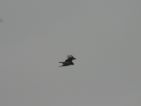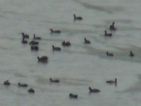
Birds in lagoon
Comparisson reports are under license of:

Lo que dice el Arxiduc:
“In the tranquil waters of the inner lagoon, objects are reflected in all their purity: towers bronzed by the passage of time, intensely white houses. And, from time to time, a seagull quickly flies past, its fleeting reflection in the water’s mirror producing a slight shiver.
Terns (Sterna cantica) frequent Sebra Bay in large flocks. On stormy nights when fishing in the inner bay, they fly about like ghosts. Normally light like butterflies, they flutter about. But, at times, like barn swallows, they shoot past like arrows. Then, suddenly, they let themselves drop to the sea like stones, almost completely submerging themselves, foam all around them; it would seem they would disappear, but they soon take flight again with a fish in their beaks. And the other ones, enviously follow them, but not with as much ferocity as the seagulls.
When raising one’s gaze, you at times see cranes, forming a V while crossing the sky.
Before, at night, you could see flamingos, but these birds have almost disappeared. They are seen only rarely here and in the lagoon where we also see wild birds, ducks and cranes. Many of them succumb to hunters who come in large numbers from Tunis.
When the right time comes, we can see large flocks of migratory birds. At times, we see quick-flying quail, and, at other times, small European robins, exhausted, lightly touching the water with their wings. Throughout their journey they have already stopped on numerous ships, impatient to reach the shore. Then there are the canes , sure of flight and fast, flying towards the lakes in the interior; or gray Puffinus cinereus, flying up high; or even northern gannets, often alone, flying by slowly.”
Archduke Ludwig Salvator of Austria, Bizerte, J. Rothschild, Paris, 1900 (Prague, 1897)
Datos proyecto Nixe III:
We were not allowed in to Bizerte’s salt-water lagoon as recreational boats are no longer permitted. As such, we were unable to observe the birds there in detail.
However, we did see flamingos in the lagoons to the north of Tunis and near the sea heading towards Bizerte.
In terms of Bizerte’s second lagoon, Ichkeul with its fresh water, we also saw several ducks, the Fulica atra (Eurasian coot), the most common species here. They flock to this lagoon in greatest number in winter, though some can be seen in winter.
We also saw different types of birds of prey in the Ichkeul natural park. In the photo we can see one such bird of prey, though we still haven’t been able to identify it.



















